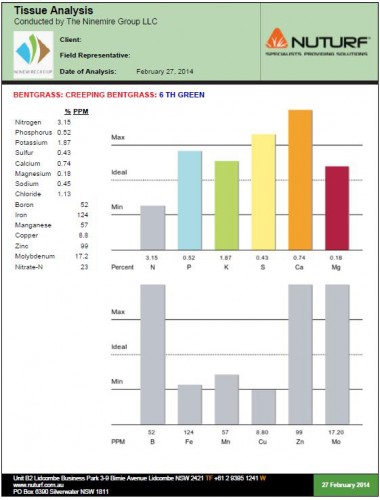
Tissue Analysis
About our tissue analysis test
The Nuturf Tissue Analysis can provides turf managers with a tool to ascertain the actual nutritional makeup of the turfgrass plant, and in turn determine if success is being achieved through the current fertiliser program. The test looks at all the major and minor nutrients, and guidelines are based on specific turfgrass species. This is important as different species have varying nutritional requirements and toxicity thresholds.
The Tissue Analysis report displays the major nutrients as a percentage, with minor nutrients displayed in parts per million (PPM). It is important to understand the relationship between these measurements in order to have a real idea of the nutrient content of the plant. 10,000 ppm is equal to one percent, so in the tissue analysis, the use of percentages relates to the concentration of the nutrients the same as the ppm figure does – not to its balance in relation to other nutrients as in a soil test base saturation.
Understanding Nuturf’s Premium Tissue Analysis
Why do we test turfgrass tissue?
All plants require nutrients for development in the correct concentrations and ratios – turfgrass species are no different. Sports turf plants are often grown in artificial soil environments, lacking in the ability to generate and retain the required nutrients. This paired with the stresses placed on turf through intensive management practices results in a high nutritional demand.
To meet the industry requirements for presentation and performance, nutritional needs must be met via the addition of nutrients through applications of fertiliser products. In order for the turf manager to select suitable products and rates for application, they must first understand the requirements of the plant, and the nutritional characteristics of their soil.
A conventional soil nutrition test will offer an insight into the nutritive quality of the soil, and will usually offer guidelines for basic turf requirements. However sometimes this does not provide the turf manager with the best picture of what the plant is actually gaining access to. This is due to the many factors that can influence the availability of these nutrients to the plant.
What better way to understand what nutrients the turfgrass plant is effectively utilising, than to analyse the tissue to quantify its nutritional content. Used in conjunction with Nuturf Soil Analysis and Saturated Soil Analysis – the Nuturf Tissue Analysis is an invaluable tool in trouble shooting, quantifying nutritional requirements and fine tuning fertiliser programs for maximum efficiency.
Features of the Analysis
The Nuturf Tissue Analysis can provide the turf manager with a tool to ascertain the actual nutritional make-up of the turfgrass plant, and in turn determine if success is being achieved through the current fertiliser program. The test looks at all the major and minor nutrients, and guidelines are based on specific turfgrass species. This is important as different species have varying nutritional requirements and toxicity thresholds.
The Tissue Analysis report displays the major nutrients as a percentage, with minor nutrients displayed in parts per million (PPM). It is important to understand the relationship between these measurements in order to have a real idea of the nutrient content of the plant. 10,000 ppm is equal to one percent, so in the tissue analysis, the use of percentages relates to the concentration of the nutrients the same as the ppm figure does – not to its balance in relation to other nutrients as in a soil test base saturation.
Sampling
To ensure the accuracy of results achieved from the analysis, the sample must be correctly collected. A sample bag of leaf clippings could be collected from the mower catcher, or cut using scissors from varying positions over the area to be tested. Avoid collecting samples during high growth periods as this can result in artificially low readings of many nutrients as they are converted to energy for plant development. Additionally, avoid collecting samples soon after fertiliser applications which will inflate nutrient content in the tissue, and could contaminate the sample.
Ask your Nuturf Territory Manager about performing a tissue analysis in conjunction with this year’s soil analysis.

Deficiency Symptoms
-
Nitrogen (N): General yellow green or chlorotic colour. Older leaves initially discoloured and dieback from tips. Shoot density and tillering decrease.
-
Phosphorus (P): Leaves progress from dark to purplish to reddish-purple in colour. Stand may appear wilted and exhibit poor spring green up.
-
Potassium (K): Older leaves exhibit yellowing first, followed by dieback at the tops and then along leaf margins.
-
Calcium (Ca): Younger leaves exhibit symptoms first, with reddish brown colour along leaf margins
-
Magnesium (Mg): Older leaves turn red to cherry red along margins
-
Sulphur (S): Similar to N deficiency, although midvein may remain green
-
Iron (Fe): Younger leaves exhibit symptoms first, typically an interveinal chlorosis. Leaves may appear almost white under severe deficiency.
-
Manganese (Mn): Interveinal chlorosis of Younger leaves. Necrotic spots may develop on leaves.
-
Zinc (Zn): Stunted leaves. Some chlorosis. Puckered leaf margins.
-
Copper (Cu): Tips of younger leaves dieback. May get white tip. Growth may be stunted.
-
Chloride (Cl): Not commonly observed in turf.
-
Sodium (Na): None
Sufficiency Ranges for Nutrient Content in Turfgrass Clippings



